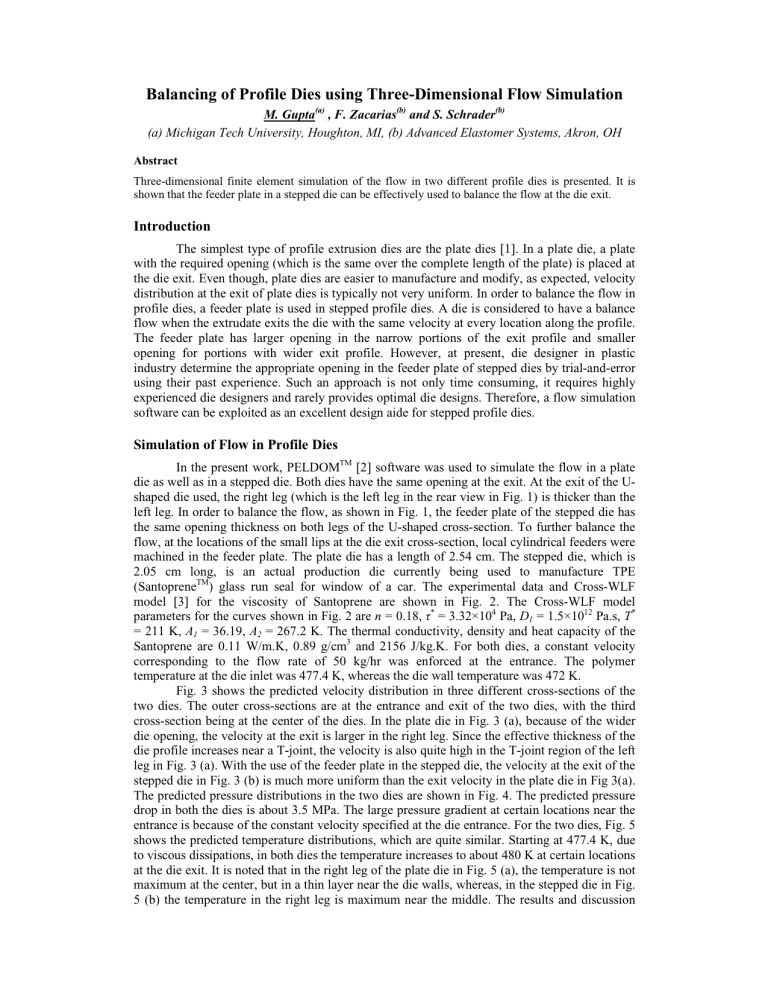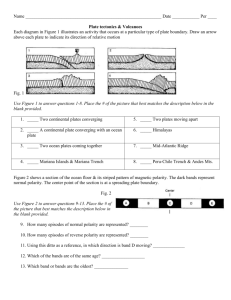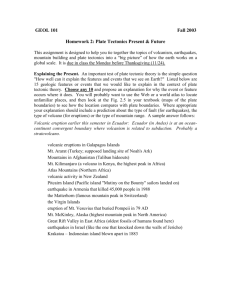Balancing of Profile Dies using Three-Dimensional Flow Simulation M. Gupta

Balancing of Profile Dies using Three-Dimensional Flow Simulation
M. Gupta
(a)
, F. Zacarias
(b)
and S. Schrader
(b)
(a) Michigan Tech University, Houghton, MI, (b) Advanced Elastomer Systems, Akron, OH
Abstract
Three-dimensional finite element simulation of the flow in two different profile dies is presented. It is shown that the feeder plate in a stepped die can be effectively used to balance the flow at the die exit.
Introduction
The simplest type of profile extrusion dies are the plate dies [1]. In a plate die, a plate with the required opening (which is the same over the complete length of the plate) is placed at the die exit. Even though, plate dies are easier to manufacture and modify, as expected, velocity distribution at the exit of plate dies is typically not very uniform. In order to balance the flow in profile dies, a feeder plate is used in stepped profile dies. A die is considered to have a balance flow when the extrudate exits the die with the same velocity at every location along the profile.
The feeder plate has larger opening in the narrow portions of the exit profile and smaller opening for portions with wider exit profile. However, at present, die designer in plastic industry determine the appropriate opening in the feeder plate of stepped dies by trial-and-error using their past experience. Such an approach is not only time consuming, it requires highly experienced die designers and rarely provides optimal die designs. Therefore, a flow simulation software can be exploited as an excellent design aide for stepped profile dies.
Simulation of Flow in Profile Dies
In the present work, PELDOM
TM
[2] software was used to simulate the flow in a plate die as well as in a stepped die. Both dies have the same opening at the exit. At the exit of the Ushaped die used, the right leg (which is the left leg in the rear view in Fig. 1) is thicker than the left leg. In order to balance the flow, as shown in Fig. 1, the feeder plate of the stepped die has the same opening thickness on both legs of the U-shaped cross-section. To further balance the flow, at the locations of the small lips at the die exit cross-section, local cylindrical feeders were machined in the feeder plate. The plate die has a length of 2.54 cm. The stepped die, which is
2.05 cm long, is an actual production die currently being used to manufacture TPE
(Santoprene
TM
) glass run seal for window of a car. The experimental data and Cross-WLF model [3] for the viscosity of Santoprene are shown in Fig. 2. The Cross-WLF model parameters for the curves shown in Fig. 2 are n = 0.18, τ *
= 3.32×10
4
Pa, D
1
= 1.5×10
12
Pa.s, T
*
= 211 K, A
1
= 36.19, A
2
= 267.2 K. The thermal conductivity, density and heat capacity of the
Santoprene are 0.11 W/m.K, 0.89 g/cm
3
and 2156 J/kg.K. For both dies, a constant velocity corresponding to the flow rate of 50 kg/hr was enforced at the entrance. The polymer temperature at the die inlet was 477.4 K, whereas the die wall temperature was 472 K.
Fig. 3 shows the predicted velocity distribution in three different cross-sections of the two dies. The outer cross-sections are at the entrance and exit of the two dies, with the third cross-section being at the center of the dies. In the plate die in Fig. 3 (a), because of the wider die opening, the velocity at the exit is larger in the right leg. Since the effective thickness of the die profile increases near a T-joint, the velocity is also quite high in the T-joint region of the left leg in Fig. 3 (a). With the use of the feeder plate in the stepped die, the velocity at the exit of the stepped die in Fig. 3 (b) is much more uniform than the exit velocity in the plate die in Fig 3(a).
The predicted pressure distributions in the two dies are shown in Fig. 4. The predicted pressure drop in both the dies is about 3.5 MPa. The large pressure gradient at certain locations near the entrance is because of the constant velocity specified at the die entrance. For the two dies, Fig. 5 shows the predicted temperature distributions, which are quite similar. Starting at 477.4 K, due to viscous dissipations, in both dies the temperature increases to about 480 K at certain locations at the die exit. It is noted that in the right leg of the plate die in Fig. 5 (a), the temperature is not maximum at the center, but in a thin layer near the die walls, whereas, in the stepped die in Fig.
5 (b) the temperature in the right leg is maximum near the middle. The results and discussion
above clearly show that a flow simulation software is a powerful tool for predicting the velocity and temperature distributions in a profile die, and for balancing the flow accordingly by modifying the die geometry before the actual die is cut.
References
1.
W. Michaeli, Extrusion Dies for Plastics and Rubber , Hanser publishers, New York (1992).
2.
PELDOM, Plastic Flow, LLC, Houghton, MI (www.plasticflow.com).
3.
C. A. Hieber, in Injection and Compression Molding Fundamentals , A. I. Isayev (Ed.),
Marcel Dekker, New York (1987).
10000
Fig. 1 Rear view of the die channel.
1000
100
10
10 100
Shear Rate (1/s)
1000
Fig. 2 Viscosity of Santoperene.
10000




